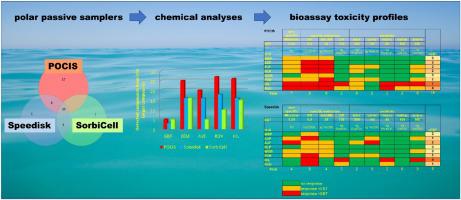Environmental Toxicology and Pharmacology ( IF 4.2 ) Pub Date : 2020-11-24 , DOI: 10.1016/j.etap.2020.103549 M. Thao Nguyen , Milo L. De Baat , Ron Van Der Oost , Willie Van Den Berg , Pim De Voogt

|
Routine water quality monitoring is generally performed with chemical analyses of grab samples, which has major limitations. First, snapshot samples will not give a good representation of the water quality. Second, it is not sufficient to analyze only a limited number of (priority) pollutants. These limitations can be circumvented by an alternative environmental risk assessment that combines time-integrated passive sampling (PS) with effect-based methods. This study aimed to select which of three polar PS devices was best suited for effect-based monitoring strategies.
In the first part of this study, Speedisk, SorbiCell and POCIS polar PS devices were compared by simultaneous deployment at five sites. Chemical analyses of 108 moderately polar compounds (-1.82 < log D < 6.28) revealed that highest number of compounds, with the widest range of log KOW, log D and pKa, were detected in extracts of POCIS, followed by Speedisk. SorbiCell samplers accumulated the lowest numbers and concentrations of compounds, so they were not further investigated. In a follow-up study, bioassay responses were compared in extracts of POCIS and Speedisk devices deployed at eight sites. The passive sampler extracts were subjected to bioassays for non-specific toxicity, endocrine disruption, and antibiotics activities. More frequent and higher responses were induced by POCIS extracts, leading to more exceedances of effect-based trigger values for environmental risks. As POCIS outperformed Speedisk, it is better suited as PS device targeting polar compounds for semi-quantitative effect-based water quality monitoring.
中文翻译:

POCIS,Speedisk和SorbiCell极性无源采样器的生物测定响应和微污染物吸收的比较现场研究
常规水质监测通常通过抓取样品的化学分析进行,这有很大的局限性。首先,快照样本不能很好地表示水质。其次,仅分析有限数量的(优先)污染物是不够的。可以通过将时间积分被动采样(PS)与基于效果的方法相结合的替代环境风险评估来规避这些限制。这项研究旨在选择三种极性PS设备中的哪一种最适合基于效果的监视策略。
在本研究的第一部分中,通过同时部署在五个站点对Speedisk,SorbiCell和POCIS Polar PS设备进行了比较。对108种中等极性化合物(-1.82 <log D <6.28)的化学分析显示,化合物数量最多,log K OW的范围最广在POCIS提取物中检测到log D和pKa,然后是Speedisk。SorbiCell采样器积累的化合物数量和浓度最低,因此无需进一步研究。在后续研究中,比较了在八个地点部署的POCIS和Speedisk设备提取物中的生物测定反应。对被动采样器的提取物进行生物测定以进行非特异性毒性,内分泌干扰和抗生素活性。POCIS提取物诱导了更频繁和更高的反应,导致更多的基于效果的环境风险触发值被超越。由于POCIS的性能优于Speedisk,因此它更适合用作针对极性化合物的PS设备,用于基于半定量效果的水质监测。











































 京公网安备 11010802027423号
京公网安备 11010802027423号